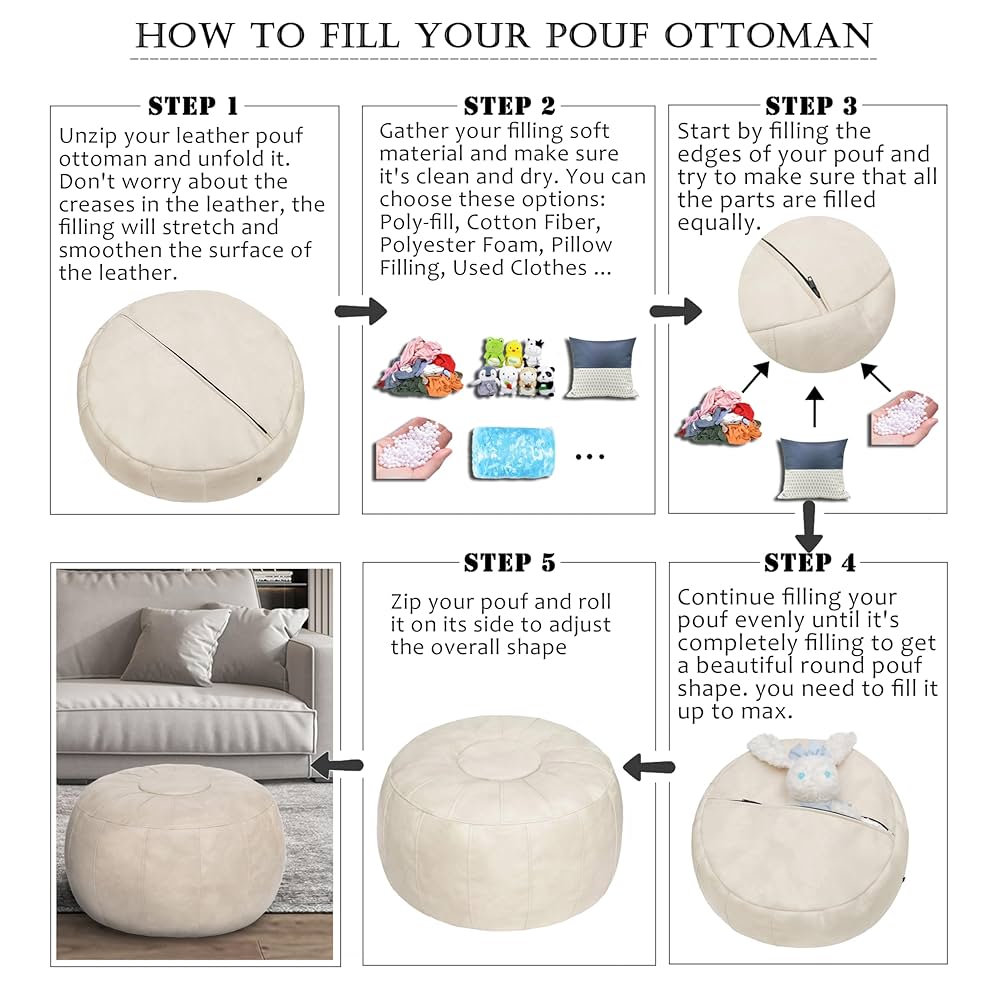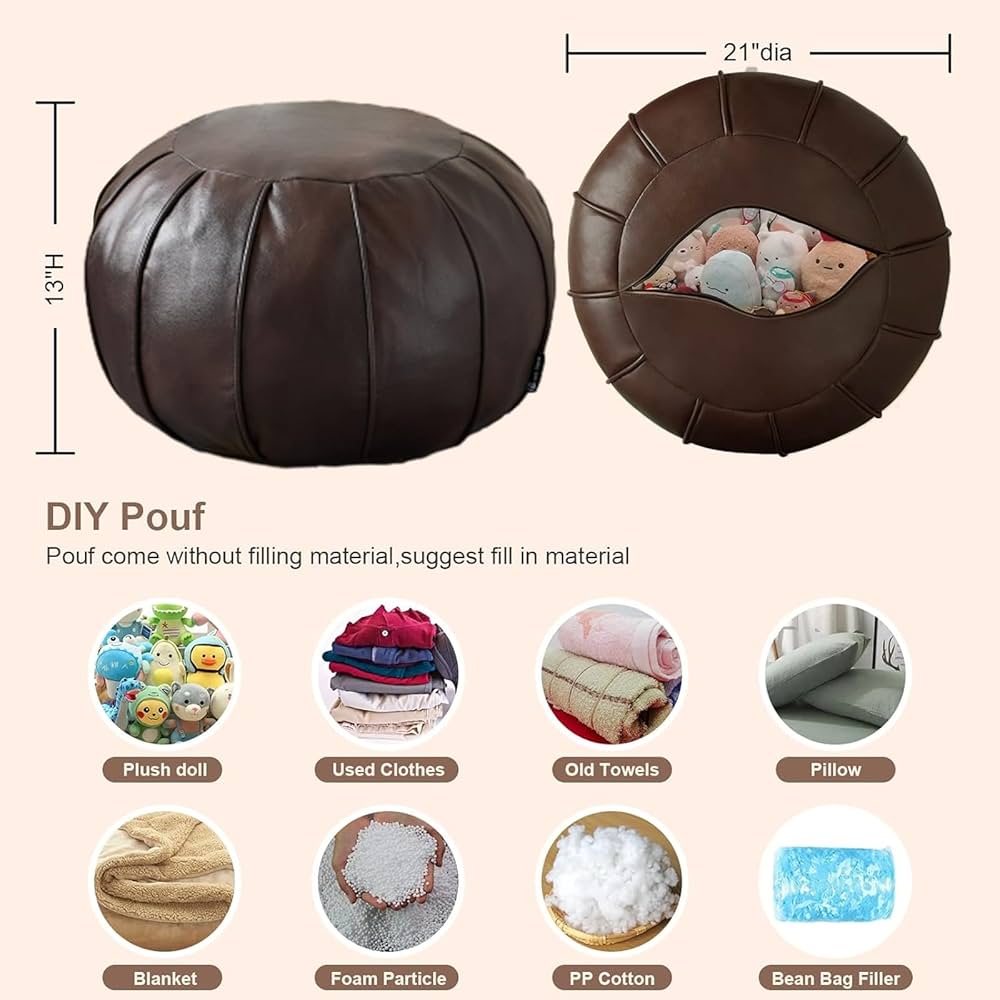Are you wondering what to fill your Moroccan pouf with to make it both comfy and stylish? Choosing the right filling can change everything—from how your pouf feels under you to how long it lasts.
Whether you want something soft and cozy or firm and supportive, the filling you pick will shape your experience. Keep reading, and you’ll discover simple options that suit your needs and budget, helping you enjoy your pouf to the fullest.

Credit: www.marrakeche.com
Types Of Filling Materials
Choosing the right filling for a Moroccan pouf affects its comfort and durability. Different materials offer various benefits. Some are soft and natural, while others are firm and synthetic. Recycled options provide an eco-friendly choice. Understanding these types helps pick the best filling for your pouf.
Natural Fibers
Natural fibers come from plants or animals. They provide a soft, breathable feel. Common natural fillings include:
- Wool – warm and soft, keeps shape well
- Cotton – lightweight and breathable
- Kapok – a fluffy fiber from seed pods, very light
- Feathers – soft and luxurious, but may need frequent fluffing
Natural fibers create a cozy, traditional pouf experience.
Synthetic Options
Synthetic fillings are man-made materials. They often last longer and resist moisture. Popular synthetic fillings include:
- Polyester fiberfill – soft, affordable, and hypoallergenic
- Foam beads – provide firm support and keep shape
- Memory foam – molds to the body for comfort
- Microbeads – small, smooth beads that add flexibility
Synthetics offer durability and easy maintenance for daily use.
Recycled Fillings
Recycled fillings use reused or repurposed materials. They reduce waste and help the environment. Examples include:
- Shredded fabric scraps – soft and eco-friendly
- Recycled foam pieces – firm and sustainable
- Plastic pellets from recycled bottles – lightweight and durable
Recycled options combine comfort with green living values.

Credit: www.amazon.ae
Pros And Cons Of Each Filling
Choosing the right filling for your Moroccan pouf affects its look, feel, and longevity. Each type of filling brings its own set of advantages and drawbacks. Understanding these will help you pick what fits your comfort needs, budget, and style best.
Comfort And Support
Memory foam offers excellent support, molding to your body shape and making long seating sessions comfortable.
On the other hand, traditional fillings like cotton or wool provide a softer, more natural feel but may compress quickly.
Polyester stuffing is lightweight and fluffy but might lack the firmness you need for good posture. What level of support do you want from your pouf—soft relaxation or firm seating?
Durability
Foam fillings tend to last longer without losing shape, making them ideal if you want your pouf to stay fresh for years.
Cotton and wool may clump or flatten over time, requiring frequent fluffing or replacement.
Polyester stuffing can degrade with heavy use, but it resists moisture and pests better than natural fibers. How often will your pouf be used? This can guide your choice toward more durable options.
Cost And Availability
Polyester stuffing is generally the most affordable and easy to find at craft or fabric stores.
Natural fillings like wool tend to be pricier and might require sourcing from specialty shops.
Memory foam falls in the mid to high price range but offers value through comfort and durability. Does your budget allow investing more upfront for long-term comfort?
How To Prepare Filling For Your Pouf
Choosing the right filling for your Moroccan pouf ensures comfort and shape. Common options include foam, polyester fiberfill, or old clothes packed tightly. Each material offers different firmness and support for a cozy, stylish pouf.
Preparing the filling for your Moroccan pouf is an essential step in ensuring comfort and style. The process involves a few thoughtful decisions that can significantly impact the end result. Whether you’re looking for a plush, soft feel or a firmer, more supportive seat, the key lies in how you prepare and mix your filling materials.Cleaning And Sanitizing Materials
Before adding any materials into your pouf, ensure they are clean and sanitized. You can use old clothes, towels, or fabric scraps, but make sure they are freshly laundered. This not only keeps your pouf hygienic but also prevents any musty odors from developing. If you decide to use foam or stuffing from old cushions, consider airing them out in the sun. Sunlight can naturally eliminate bacteria and odors, providing a fresh start for your pouf stuffing.Mixing Different Fillings
Experimenting with different fillings can help you achieve the perfect balance of comfort and support. You might mix shredded memory foam with polyester stuffing for a combination of softness and resilience. Old newspapers can also be crumpled and added for extra firmness, offering an eco-friendly solution. This mix-and-match approach allows you to tailor the pouf to your specific comfort needs.Adjusting Firmness
Do you prefer a pouf that’s soft and squishy or firm and supportive? Adjusting the firmness is easy once you have your materials prepared. Add more soft materials like old clothes for a cushier feel, or incorporate firmer items like foam for added support. Test the pouf as you fill it by sitting on it to gauge how it feels. This hands-on approach ensures that you achieve the exact level of firmness you desire.Step-by-step Filling Process
Filling a Moroccan pouf requires care to ensure it holds shape and stays comfortable. The process involves selecting the right tools, using proper techniques, and sealing the pouf securely. Each step helps your pouf last longer and look great in your space.
Tools You Need
- Stuffing material (foam, cotton, or fabric scraps)
- Large funnel or scoop
- Measuring cup or container
- Strong needle and thread
- Scissors
- Protective gloves (optional)
Filling Techniques
Use small amounts of stuffing at a time. This helps distribute the filling evenly. Press down gently to avoid lumps. Use the funnel to guide stuffing inside the pouf. Shake the pouf lightly to settle the material. Repeat filling and shaking until full and firm.
Sealing Your Pouf
After filling, close the opening carefully. Use a strong needle and thread to sew the pouf shut. Stitch tightly to avoid any filling escaping. Double stitch for extra strength. Trim any loose threads for a neat finish.
Maintenance Tips For Filled Poufs
Keeping your Moroccan pouf looking and feeling great depends heavily on how well you maintain its filling. Proper care not only extends the life of your pouf but also ensures it stays comfortable and inviting. Let’s look at some practical tips to keep your filled pouf in top shape.
Fluffing And Reshaping
Regular fluffing helps maintain your pouf’s shape and comfort. Give it a good shake and squeeze every few days to redistribute the filling evenly. If you notice any flat spots, gently knead those areas to bring back the original form.
Have you ever sat on a pouf that felt lumpy or uneven? Fluffing prevents that unpleasant experience and keeps your pouf looking fresh.
Replacing Fillings
Over time, fillings like polyester fiberfill or foam beads may compress or break down. Keep an eye on how firm your pouf feels. If it starts losing support or becomes too squishy, it’s time to add or replace the filling.
You can easily open the zipper (if your pouf has one) and add more stuffing or completely swap it out. This simple step can bring new life to your pouf without buying a new one.
Preventing Odors And Moisture
Fillings can trap moisture, leading to unpleasant smells or even mold growth. To avoid this, keep your pouf in a dry area and avoid exposure to dampness. Sprinkle baking soda inside the pouf and let it sit for a few hours before vacuuming to neutralize odors.
Have you noticed a musty smell from your pouf? Taking these small steps can keep it smelling fresh and extend its usability.

Credit: www.amazon.ca
Creative Filling Alternatives
Creative filling alternatives can make your Moroccan pouf unique and practical. Choosing the right filling affects comfort, shape, and eco impact. Exploring different materials offers fresh ideas beyond traditional stuffing.
Upcycled Materials
Old clothes and fabric scraps work well for pouf filling. They create a soft, flexible cushion. Use torn T-shirts, sweaters, or jeans cut into small pieces. This method reduces waste and saves money.
Other options include shredded cardboard or foam pieces. These materials add firmness and structure. Collect from packaging or old cushions to reuse. Upcycled fillings bring new life to discarded items.
Eco-friendly Choices
Natural fibers make excellent, sustainable pouf stuffing. Wool, cotton, or kapok offer breathability and softness. These materials are biodegradable and safe for indoor use.
Another choice is buckwheat hulls, popular for firm support. They mold to body shape and stay cool. Coconut coir also provides a sturdy base with natural resistance to moisture.
Combining Textures
Mixing different fillings enhances comfort and durability. Use soft fibers with firmer materials for balanced support. For example, blend cotton scraps with foam bits.
This approach allows customization of pouf firmness. Layer materials in the pouf cover for varied feel. Combining textures creates a cozy and stylish seating option.
Frequently Asked Questions
What Materials Are Best To Fill A Moroccan Pouf?
Optimal fillings include polyester fiberfill, foam beads, or recycled fabric scraps. These materials offer comfort, durability, and maintain the pouf’s shape well over time.
Can I Use Old Clothes To Stuff My Moroccan Pouf?
Yes, old clothes can be shredded and used as stuffing. They provide softness but may compress faster, requiring occasional fluffing or replacement.
How Much Filling Do I Need For A Moroccan Pouf?
Typically, fill the pouf tightly but leave some softness. About 2-3 kilograms of stuffing is enough for a standard 18-inch pouf.
Is Foam Better Than Polyester For Moroccan Pouf Filling?
Foam offers firmer support and lasts longer. Polyester is lighter and softer but may flatten quicker. Choose based on comfort preference and usage.
Conclusion
Choosing the right filling for your Moroccan pouf makes a big difference. You want it soft but supportive. Common fillers include foam, polyester fiber, or old clothes. Each option changes the feel and look. Think about how you plan to use the pouf.
Do you want it firm or squishy? The right stuffing makes your pouf comfy and stylish. Take your time to decide what suits your needs best. Enjoy your unique, cozy Moroccan pouf every day.





